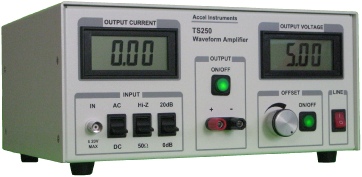








Instruments For Testing Your Innovations


IIRVINE, California, April 20, 2015 – The TS250 waveform amplifier is a unique test equipment ideal for function generator amplifier. It amplifies current or voltage or power for driving high current loads such as Helmholtz coils and piezo elements.
The TS250 is ideal for many test and measurement applications such as LDO and amplifier PSRR tests, battery simulator, op-
Function Generator Amplifier
The TS250 is ideal as a function generator amplifier for amplifying current. It can drive high current or high power or high voltage loads. It can output up to 6A peak current for the low-
Battery Simulator
The TS250 can source or sink current in all four quadrants. It is an excellent instrument for use as a battery simulator to test battery charger circuits. It provides a variable DC voltage output that can quickly simulates battery voltage changes. The TS250 features an LCD-
A battery simulator is an electrical device that can simulate many of the battery characteristics. These characteristics are the capability to sink current, and able to deliver power, current, voltage and more. The battery simulator provides the required current, power, and voltage to the mobile system similar to an actual battery would. Usually a battery simulator will replace the battery inside a mobile device for testing purpose. The battery simulator allows design engineers to easily and thoroughly test these handheld systems. Extensive verification testing is needed during system design and mass production stage.
Charger circuit that charges the battery is included inside a lot of portable systems. The charger circuit must be fully and thoroughly tested to be certain it meets all of the specs and safely charges the battery. From dead battery to full, a charging cycle often will take several long hours to complete. Therefore it requires several hours to test just one charging cycle. Thorough testing requires many charging cycle tests. If the battery is replaced with a battery simulator, a complete charging cycle test can be done in mere seconds. Similarly, it could take a few days to empty an actual battery in a handheld system. On the other hand, a battery simulator can easily emulate an empty battery with a touch of button. At the same time, test engineers can monitor how the system and charger reacts as the “battery” is depleted. A battery simulator can test electronic charging device to make sure that it meets all of the specifications without waiting for hours. In addition, a battery simulator can quickly emulates an overcharge battery and a completely drained battery (0V), both of which conditions are difficult to do with an actual battery in a system.
Mid-
PSRR/CMRR Measurement
TS250 is ideal for power supply rejection ratio or PSRR measurement. PSRR is commonly tested for LDO regulators, op amps, audio amps, and more. The TS250 is especially useful for LDO PSRR testing at high load current. Conventional regulator PSRR test techniques such as capacitor or inductor coupled unable to support high LDO load current (e.g. >1A). The TS250 can also test op-
In summary the TS250 is easy to use and intuited. It is designed for general laboratory applications such as function generator amplifier, battery simulator, Helmholtz coil driver, PSRR/CMRR testing, transient response testing, four-
About Accel Instruments
Accel instruments designs, develops, manufactures and markets electronic instruments for the specialized needs of electronics bench testing and research and development. We specialize in power electronic test and measurement such as voltage regulators, battery simulator, waveform amplifier, and more. Additional information about Accel instruments is available at www.accelinstruments.com.
Accel Instruments Announces the TS250 Waveform Amplifier - An Instrument for Amplifying Function Generators



TS250-0: -10V to + 10V
TS250-1: -20V to + 20V
TS250-2: -30V to + 30V
TS250-3: -40V to + 40V
TS250-4: -6V to + 15V
TS250-5: -6V to + 30V
TS250-6: -6V to + 45V
TS250-7: -6V to + 65V

TS250 Voltage Ranges

Quick Links


